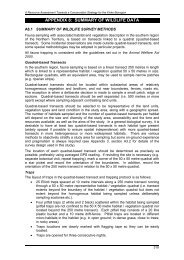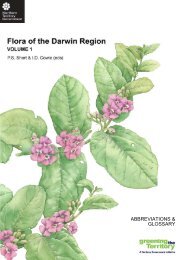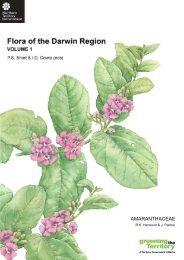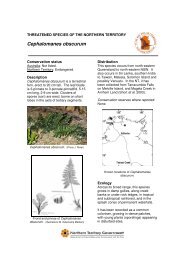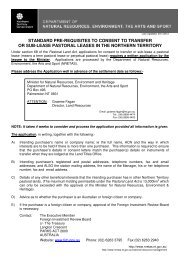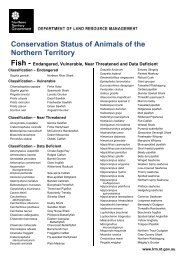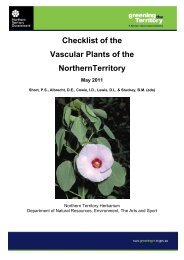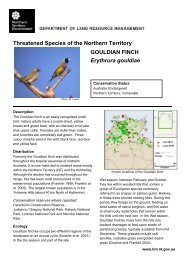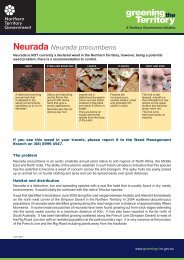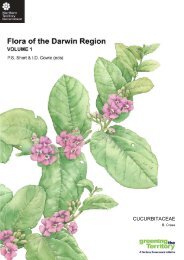Guidelines and Field Methodology for Vegetation Survey and Mapping
Guidelines and Field Methodology for Vegetation Survey and Mapping
Guidelines and Field Methodology for Vegetation Survey and Mapping
Create successful ePaper yourself
Turn your PDF publications into a flip-book with our unique Google optimized e-Paper software.
SECTION A: GUIDELINES<br />
Structural<br />
Formation<br />
Formation classes defined by growth <strong>for</strong>m <strong>and</strong> crown separation<br />
(woody plants) or foliage cover (ground stratum), <strong>and</strong> qualified by<br />
height class (i.e. NVIS In<strong>for</strong>mation Hierarchy Level II – Structural<br />
Formation; refer to Chapter 5.1).<br />
Walker & Hopkins,<br />
1990<br />
Association<br />
Association<br />
An association is defined as a climax community of which the<br />
dominant stratum has a qualitatively uni<strong>for</strong>m floristic composition<br />
<strong>and</strong> which exhibits uni<strong>for</strong>m structure as a whole.<br />
OR<br />
A series of climax plant communities which have (i) the same<br />
structural characteristics, (ii) the same species as dominants in the<br />
uppermost stratum, though (iii) possibly different floristic<br />
composition in the understorey, can be grouped together as an<br />
association.<br />
For each stratum, the association description of the vegetation<br />
type should include floristic in<strong>for</strong>mation <strong>for</strong> the dominant <strong>and</strong>/or<br />
diagnostic species (maximum of three species per stratum) plus<br />
the structural <strong>for</strong>mation (dominant growth <strong>for</strong>m, cover, height are<br />
combined). A maximum of three strata (upper, mid & ground;<br />
Walker & Hopkins, 1990) are allowed <strong>and</strong> the dominant stratum is<br />
indicated by a plus symbol “+” (i.e. NVIS In<strong>for</strong>mation Hierarchy<br />
Level V – Association; refer to Chapter 5.1).<br />
Beadle & Costin, 1952<br />
NVIS**<br />
Sub-<br />
Association<br />
A sub division of the association determined by a variation in the<br />
most important subordinate stratum of the association, without<br />
significant qualitative changes in the dominant stratum.<br />
Beadle & Costin, 1952<br />
Sub-<br />
Association<br />
In NVIS, <strong>for</strong> each layer/sub-stratum, the sub-association<br />
description of the vegetation type should include floristic<br />
in<strong>for</strong>mation <strong>for</strong> the dominant <strong>and</strong>/or diagnostic species (maximum<br />
of five species per sub-stratum) plus the structural <strong>for</strong>mation<br />
(dominant growth <strong>for</strong>m, cover & height) are combined. A maximum<br />
of eight sub strata are allowed <strong>and</strong> the dominant sub-stratum is<br />
indicated by a plus symbol “+” (i.e. NVIS In<strong>for</strong>mation Hierarchy<br />
Level VI – Sub-association; refer to Chapter 5.1).<br />
* ERIN: Department of Environment <strong>and</strong> Heritage – Environmental Resources In<strong>for</strong>mation Network<br />
** NVIS: Department of Environment <strong>and</strong> Heritage – National <strong>Vegetation</strong> In<strong>for</strong>mation System<br />
NVIS**<br />
3.1 <strong>Survey</strong> Design<br />
The design <strong>and</strong> implementation of a survey depend on:<br />
1. The purpose of a survey is influenced by the scale of mapping <strong>and</strong> data detail<br />
required. This is clearly defined at the beginning including geographic extent, type of<br />
mapping <strong>and</strong> classification system, <strong>and</strong><br />
2. Resources available including funds, staff, equipment <strong>and</strong> vehicles.<br />
The major steps involved include:<br />
1. Establishing the aims <strong>and</strong> objectives of a survey <strong>and</strong> required outputs;<br />
2. Defining the methods <strong>and</strong> procedures to conduct the survey <strong>and</strong> analyse data;<br />
3. Undertaking an in<strong>for</strong>mation search <strong>for</strong> available material <strong>and</strong> data to assist with all<br />
components of the survey;<br />
4. Undertaking the survey (preliminary mapping, field survey, data analysis, final<br />
mapping & attribution), <strong>and</strong><br />
5. Presentation of results (reports, maps, & meta-data requirements).<br />
Northern Territory <strong>Guidelines</strong> <strong>and</strong> <strong>Field</strong> <strong>Methodology</strong><br />
<strong>for</strong> <strong>Vegetation</strong> <strong>Survey</strong> <strong>and</strong> <strong>Mapping</strong><br />
4



